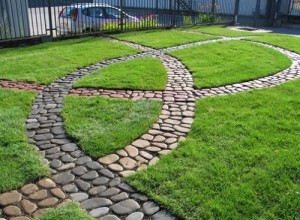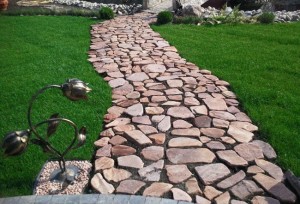Every year, more and more inveterate summer residents realize that a suburban area can be not only a hopeless canvas of many vegetable beds, but also a resting place for body and soul. Even an ordinary cobblestone path can radically transform the garden. A summer house with neat sidewalks and a layout testifies to the hard work of its owner and his taste.
Not every garden owner can afford the services of a specialist who perfectly knows the technology of laying such paths. But, having got acquainted with the theory a little, you can independently create cobblestone paths with your own hands to taste and financial capabilities.
Material selection
The most democratic and universal material for paths in the yard is natural raw materials. It has several advantages compared to its artificial counterparts:
- The heterogeneity of shapes, colors and patterns. The path will not look monotonous.
- Resistance to mechanical damage and long service life. The stone is not sensitive to extreme changes in temperature and humidity.
- The texture of the material is not destroyed by chemical reactions.
- Environmental friendliness.
 As an alternative to ready-made pieces of stone, many craftsmen choose concrete. To pave the cobblestone paths in the country, you can use both ready-made concrete slabs and make them on your own. For this, workpieces of the required shape and size are used, into which the material is poured. Thus, you can independently create a unique ornament of the track.
As an alternative to ready-made pieces of stone, many craftsmen choose concrete. To pave the cobblestone paths in the country, you can use both ready-made concrete slabs and make them on your own. For this, workpieces of the required shape and size are used, into which the material is poured. Thus, you can independently create a unique ornament of the track.
Preparatory work
Cobblestone paving occurs in several stages. And the first of them is determining the layout of future paths in the garden. Knowing the main points to which the paths should lead, the owners can show originality in the design of their bends. As a rule, a stone path connects flowerbeds and lawns, playgrounds and gazebos in the yard, small ponds or fountains, alpine slides, etc. It is not recommended to allow right angles when cornering and crossing paths, it looks too strict for a summer cottage.
The minimum width of the alley must allow free movement of the garden cart along it. Its length (in square meters) is carefully calculated before buying raw materials. Then the outlined silhouette is drawn with white on the ground.
At the preparatory stage, the master digs a trench on the site of the future track. The depth of the workpiece is determined depending on the size of the stone, but is at least 15 cm. The width exactly matches the width of the path.
Then a layer of rubble is poured into the bottom of the trench (not more than 3 cm). The next layer is fine-grained gravel; the uppermost is sand. Each layer must be properly tamped.
Cobble Stacking
In order to make sure that all the stones for the alley are ready for paving and selected in size, they must first be folded on the ground around the perimeter of the prepared foundation. If all the pieces correspond to each other, then they must be pressed harder into the sand with a rubber mallet.
 After every two meters of stone laid, the joints between it should be filled with a fixing solution. The solution for cobblestone garden paths is made independently from a mixture of sand and cement in a ratio of 1: 3. It is more convenient to fill the slots with a cone from a cement bag.
After every two meters of stone laid, the joints between it should be filled with a fixing solution. The solution for cobblestone garden paths is made independently from a mixture of sand and cement in a ratio of 1: 3. It is more convenient to fill the slots with a cone from a cement bag.
Upon completion of filling up the gaps and drying the mortar, the cobblestone garden paths are ready for use.
Despite its unpretentiousness, stone alleys still require minimal care. With proper installation and reasonable operation, garden paths will be the highlight of any summer cottage.